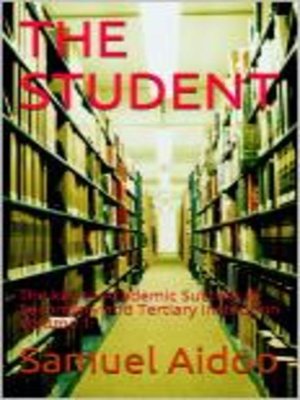THE STUDENT
ebook ∣ The Key to Academic Success in Secondary and Tertiary Institutions · SamAid Motivational
By Samuel Aidoo

Sign up to save your library
With an OverDrive account, you can save your favorite libraries for at-a-glance information about availability. Find out more about OverDrive accounts.
Find this title in Libby, the library reading app by OverDrive.



Search for a digital library with this title
Title found at these libraries:
| Library Name | Distance |
|---|---|
| Loading... |
'THE STUDENT' is a motivational book fundamentally related to the secondary school student and additionally applicable to the tertiary student, and it aims to assist the student to achieve academic success. I was inspired to compile this book from 2015 during my teaching career in South Africa when most of my students approached me with divergent academic challenges. Some of these challenges had to do with my subject area , and others had to do with general academic challenges that impeded their ability to succeed in school. In most cases, I was performing the role of a counselor offering them psychological support as to how best they can strategize to succeed in their learning. My experience augmented when I finally became a principal of a secondary school handling a plethora of academic challenges, and this positioned me to complete this book.
In this book, the author perceives the process of achieving academic success as a journey. In this journey the student should know who he is, where he is, where he is going and how he can get there. This is embodied in the mathematical model A=3W+H, the main formula to which everything in volume 1 and 2 is anchored. 'A' represents academic success; first, second and third 'W' respectively represent who the student is, where the student is and where the student is going; and H represents how the student will get to where he is going.
The model is validated by the contents in volume 1 and 2. If this journey can be very successful, it is imperative that in the course of the journey the student accurately answers the following questions:
Who am I and where am I? - representing a holistic view of the student or the learner and the learning environment. It also represents the student's position in terms of academic achievements and maturity. The student should know himself; what he can do and cannot do; and how he can make the most of the learning environment.
Where am I going? - representing what the student wants to attain academically. What are the student's reasons for going to school? Where does the student want be in the future? This means putting clarity on what you want by defining your academic mission. This mission can easily be achieved by decomposing them into goals and specific objectives.
How do I get there? - representing what you can actually do to achieve your academic mission. This is the means to an end (academic mission). How the student can get there revolves around two areas, namely, what he has to do and the resources to use.
A lot of challenges may arise as the student tries to make the most of the learning environment; there is the need to have problem-solving skills. These problem-solving skills are essential in maintaining good relationships with people within and outside the school community so that learning becomes easy. It is needful that the student builds good relationships with the people in the learning environment as he/she cannot survive alone. The student must be versed with the right learning skills in order to acquire the needed knowledge. Learning is also facilitated when the student has an attitude of self-motivation. Self-motivation is very important as it does not come from outside whereby in some instances it cannot be found. It is also important as it prepares you well to go through the assessment process easily. The student must reproduce the knowledge acquired in the highest possible level for a reward or promotion. This necessitates indelible skills in passing examinations, the basis of the assessment process. The student should be able to manage the limited resources he has including time, money and learning materials. The...







